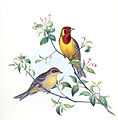Red-headed bunting
| Red-headed bunting | |
|---|---|
 | |
| Male in Kazakhstan | |
| Conservation status | |
| Scientific classification | |
| Kingdom: | Animalia |
| Phylum: | Chordata |
| Class: | Aves |
| Order: | Passeriformes |
| Family: | Emberizidae |
| Genus: | Emberiza |
| Species: | E. bruniceps |
| Binomial name | |
| Emberiza bruniceps Brandt, 1841 | |
The red-headed bunting (Emberiza bruniceps) is a passerine bird in the bunting family Emberizidae, a group now separated by most modern authors from the finches, Fringillidae.
It breeds in central Asia. It is migratory, wintering in India. Its status in western Europe, where it is a potential vagrant, is confused by escapes, especially as this species is more commonly recorded than the closely related black-headed bunting, despite the latter having a more westerly breeding range. Reports in Britain have declined dramatically over recent years, coinciding with the decline in Asiatic imports for the cage-bird trade.
The red-headed bunting breeds in open scrubby areas including agricultural land. It lays three to five eggs in a nest in a tree or bush. Its natural food consists of seeds, or when feeding young, insects.
This bird is 17 cm long, larger than reed bunting, and long-tailed. The breeding male has bright yellow underparts, green upperparts and a brownish-red face and breast.
The female is a washed-out version of the male, with paler underparts, a grey-brown back and a greyish head. The juvenile is similar, and both can be difficult to separate from the corresponding plumages of black-headed bunting.
The song, given from a high perch, is a jerky sweet-sweet-churri-churri-churri.
Gallery
-

Painting
-

Male
-
_W.jpg)
Juvenile in Kinnerasani Wildlife Sanctuary, Andhra Pradesh, India
-

Eggs of Emberiza bruniceps MHNT
References
- ↑ BirdLife International (2012). "Emberiza bruniceps". IUCN Red List of Threatened Species. Version 2013.2. International Union for Conservation of Nature. Retrieved 26 November 2013.
- Buntings and Sparrows by Byers, Olsson and Curson, ISBN 1-873403-19-4
External links
| Wikimedia Commons has media related to Emberiza bruniceps. |
- OBC 22 photographs (see pulldown menu at page bottom)
